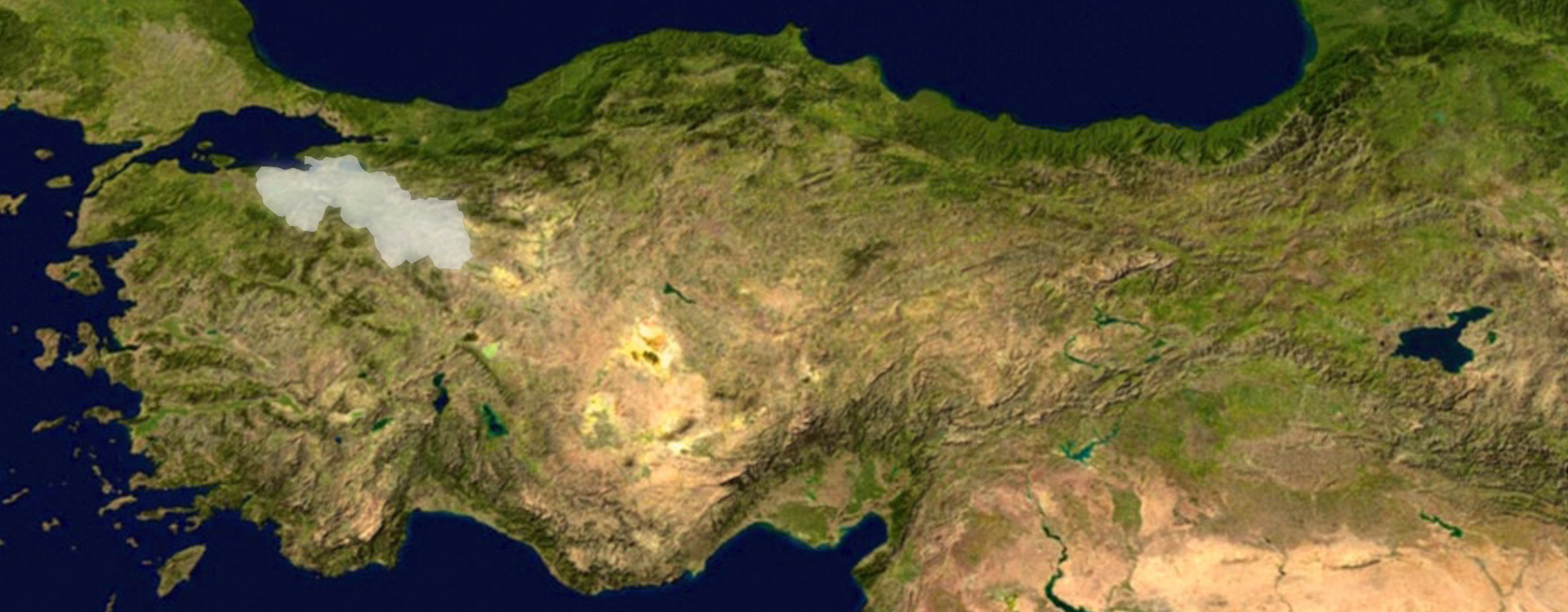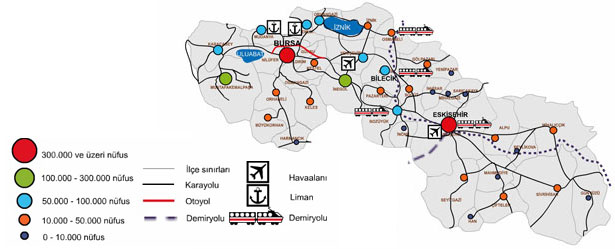
TR41 REGION
Literacy rate as of 2018 in the region is 97,8%. Net schooling rates of primary-school and secondary education in the region is quite above the averages of Turkey. In parallel with the industrial development, technical and vocational high schools in the region outnumber general high schools. There are three universities in Eskisehir, two universities in Bursa and one in Bilecik. Especially Anadolu University in Eskişehir is a leading institution which offers open education across the whole country.
TR41 Statistical Region, interconnecting the Central Anatolia and Marmara Regions, has a surface area of 29.095 km2 and a population of 4.163.022 as of 2019. The region consists of Bursa, Eskisehir and Bilecik provinces. Population growth per annum of the region is 17,9‰, population density is 146 person/km2 and these rates are above the average of Turkey. Average household size of 3 is below the average of Turkey.
Heart of Economy
The region ranks at the third place among Level 2 Statistical Territories with 12.938$ of Gross Added Value per capita. Unemployment rate of 11,2% of TR41 region progressed below the average of Turkey-wide in 2019. Labor force participation rates are 69,6% for men and 33,1% for women.
Region TR41 makes a significant contribution to the national economy by means of foreign trade surplus. By 2019, export reached $12,1 billion and imports amounted to $8,7 billion. Almost whole volume of foreign trade is being done in Bursa. France, Italy and Germany are the leading export destinations of the region. Automotive, textile, ready-made clothing, food, base metal industry, cement and soil products, chemical-plastic sector are among the most important export items. In terms of international direct investments which have a benecial effect on export and employment, Bursa is in a better condition than Eskisehir and Bilecik which also have significant potentials.
TR41 Region comes to the forefront especially with textile, ready made clothing, automotive, food, machine, electrical equipment and ceramic industries. Turkey’s leading manufacturers in chemical industry, furniture, mining and metal industries carry out their activities in the region.
There are 27 Organized Industrial Sites in the region and new ones are planned to be established. Small industrial areas are dense in the region and in parallel with Turkey-wide, SME’s (small and medium sized enterprises) form 99,7% of the enterprises. Production of high-tech products depends on Research&Development activities in the industries. In spite of the increasing number of researches in the region, an efficient cooperation between university and industry could not be obtained and R&D potential has not been revealed at a satisfactory level.
Region is also rich in natural resources. Especially marble in Bilecik, meerschaum and boron in Eskisehir, tungsten in Bursa Uludag are the region’s prominent underground wealth. The creation of value-added processing of minerals,utilization of lignite with on-site thermal power plants, conducting studies on this issue of alternative products such as boron are some of the strategic studies.
Region TR41 has 4,03% of agricultural lands in Turkey as of 2017. 87,8% of these agricultural lands are cultivated areas and the remaining consists of vegetable gardens, orchards, olive groves, forage plants and fallow areas. The region has concentrated upon plants and agricultural products used in sugar manufacture and production of vegetables and fruits such as peach, pear, olive, black fig, cherry and especially tomato which is used as input in the agricultural industry. Black fig, peach, pomegranate and raspberry have a prominent role as brand creating products.

Logistic Junction
Bursa province is developed in maritime and airline transports, however; in Eskisehir and Bilecik road and railway transports are most common. The most significant problem in the region’s logistics is the access difficulty from production areas to maritime, railway and airline terminals. Turkish State Railways (TCDD) named Bozüyük/Bilecik as one of the 16 ‘logistics village’ pin Turkey. The region experienced a significant increase in length of the railway in the last years, the length of railways reached 811 km in the region since 2017. By TCDD, High Speed Train (YHT) services are launched between Eskisehir-Ankara, and the transport of passenger beween Bursa-Ankara is carried out by the train-bus combination. In addition, the Bandırma-Bursa-Osmaneli project is an important railway projects among the railway projects. Gebze Gulf transition and Bursa-Izmir Highway project will affect logistic sector positively. Maritime transport of the region is provided via Gemlik Port in Bursa. Besides; there is an airport both in Eskisehir and Bursa.
Region TR41 is marked with various historical and cultural heritage and natural wealth. The region is where the Ottoman Empire had been established. There are important archaeological remains of Phrygia, Roman and Byzantine culture and civilization. There are winter, thermal-health, historical-cultural, religious, fair-convention, nature, air sports, auto-safari, hunting and coastal tourism facilities in the region. It also has a potential for yacht tourism, golf tourism, sports, gastronomy, shopping and rafting tourism and researches are made to make use of this potential. The fact that overnight stay periods of the tourists are below the average of the country and low occupancy rates of rest stops indicate the problems of efficiency and advertisement.
The priority environmental problem emerges as water pollution in the region. However, considering environmental indicators such as the ratio of the total population receiving waste services, or the population receiving sewage service in municipalities municipalities, TR41 region is above the national average rate. Separation of solid waste, recycling and municipal waste storage facility constructions is important. Use of geothermal, wind, solar, hydroelectric renewable energy sources, to reduce the environmental polutiond and reducing dependence on natural gas and electricity production is gaining importance. In this context, assessment of the potential for hydroelectric energy sector investments in the province of Eskişehir in the foreground.








